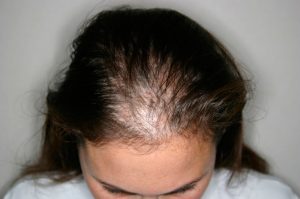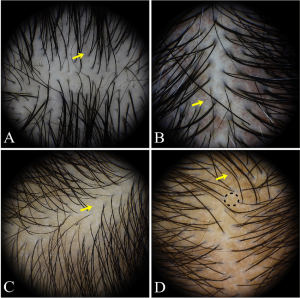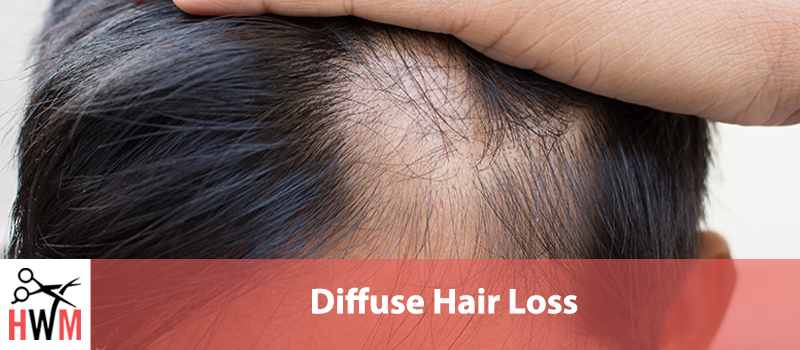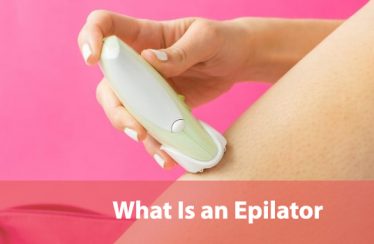Hair loss of any type is distressing and even traumatic. It can make it seem impossible to go out without being embarrassed. Hair loss makes it harder to feel like you look good, even when you do.
Often, trying to mask hair loss makes the issue even more obvious instead of helping.
Diffuse hair loss is one of the most distressing forms of hair loss since it looks and feels like you’re losing all of your hair at once instead of in a more recognizable hair loss pattern.
In this guide, we’ll discuss what makes diffuse hair loss different from other, more common, forms of hair loss, who is most likely to get diffuse hair loss, the risk factors for diffuse hair loss, and what you can do to treat the condition.
- What Makes Diffuse Hair Loss Different?
- Easy Signs of Diffuse Hair Loss
- Who is Most Likely to Get Diffuse Hair Loss
- Risk Factors for Diffuse Hair Loss
- Types of Diffuse Hair Loss
- What You Can Do
- Hair Loss Treatments
- At-Home Hair Loss Interventions
What Makes Diffuse Hair Loss Different?
Several things make diffuse hair loss significantly different from other forms of hair loss.
For one thing, diffuse hair loss isn’t necessarily progressive or permanent. Especially in men, who get chronic recurring diffuse hair loss less often than women, diffuse hair loss is usually a reaction to something and can be reversed.
But, diffuse hair loss can be difficult to spot early, for a couple of reasons. Since the hair loss is typically distributed through all or most of your scalp, it has to progress quite a bit further than other types of hair loss before it’s visible.
Diffuse hair loss can also come on suddenly, with most of the hair shedding taking place over only a month or two, and then growing back over the next 3-12 months.
That kind of loss is sudden and traumatic compared to male pattern baldness, receding hairlines, and aging, which are gradual processes and usually happen over the course of years, not months or weeks.
Easy Signs of Diffuse Hair Loss

Diffuse hair loss is hard to spot early, and once you have symptoms it usually takes a few months for treatments to kick in and start restoring your hair.
There are a few signs you can look for but spotting diffuse hair loss early is difficult.
If you start noticing any of these early signs and symptoms consistently, it’s probably time to make a doctor or dermatologist appointment.
While these signs can clue you into what’s happening before your hair loss is visible, you already have diffuse hair loss by the time you notice them. The severity of your hair loss can vary quite a bit, but you should expect some degree of loss over the next couple of months.
Expect re-growth to take time and be patient with whatever treatment plan you choose, nothing is an instant cure when it comes to hair loss.
If you notice more hair on your pillow, in your brush, or in the shower, those are good indications of hair loss of some kind.
To test for diffuse hair loss, grab a 1-3” portion of your hair and gently tug from the roots to the ends of your hair. Gently is key here, this shouldn’t be uncomfortable or painful in any way. If it does hurt, switch to a different section of hair and try again with less pressure on your hair.
Count the hairs that come free when you do this. 1-5 hairs are normal, and not a sign of hair loss. More than that might be a cause for concern and signal it’s time to make an appointment.
Many more hairs (2-3x or more), or if you’re removing sections of hair when you do this, and you should see a doctor as that can be a sign of more urgent medical issues.
Another, less common, sign of diffuse hair loss can be your hair suddenly or drastically changing texture.
Specifically, if your hair transitions from terminal, or long thicker hair, to vellus hairs, the small thinner ‘baby hairs’ that typically grow on the back of your neck, that is a sign of several types of hair loss, including diffuse hair loss.
If you notice that kind of transition in your hair, consult with a dermatologist.
They’ll be able to more accurately assess which type of hair loss or hair damage you’re experiencing and can help you treat it accordingly.
Who is Most Likely to Get Diffuse Hair Loss
Diffuse hair loss is more common in women than in men. It’s also common a few months after giving birth, so best to avoid talking about it if you notice your wife’s hair thinning when you have a new baby in the home. Unless, of course, she brings it up first.
Diffuse hair loss can also be a reaction to a traumatic experience, significant illness, malnutrition, and several other serious complications.
If you were in a major car crash, for example, you might experience acute diffuse hair loss a few months after the crash.
Your hair should grow back completely, as well, unlike other forms of hair loss that can cause permanent scarring or follicle damage.
People with eating disorders are at greater risk of diffuse hair loss. Certain vitamin deficiencies, like vitamin D, E, and A, can also contribute to diffuse hair loss.
Be cautious if you choose to supplement vitamins E and A, while a deficiency can cause hair loss, taking too much has also been connected to hair loss.
The death of a loved one and other traumatic events are all possible causes of acute diffuse hair loss.
Risk Factors for Diffuse Hair Loss
There are other risk factors for diffuse hair loss, which have more to do with your family history and physical health.
Genetic Factors
You’re slightly more likely to get diffuse hair loss if you have family members who’ve experienced the condition. Whether they developed a short-term hair loss event or developed one of the chronic forms of diffuse hair loss, you’re more likely to get one or both varieties.
Like other types of hair loss, your maternal family history is more important than your paternal family history.
That’s because most of the genes that contribute to hair loss are passed down on the X chromosome.
Remember that diffuse hair loss is more common in women than in men. Even if you have an aunt who developed severe diffuse hair loss, you aren’t doomed. You should just be aware that your risk is a little higher, and try not to stress too much if you do notice some hair loss after an illness or period of high stress.
Hormone Changes
Along with aging, hormone changes can have a big effect on the texture and density of your hair. Your hormones will naturally change over time, and most of those changes won’t harm your hair.
However, if you start a hormone therapy medication, or develop a disorder that affects your hormone levels, you should expect to see some differences in your hair. While rare, those changes can include diffuse hair loss.
If you notice diffuse hair loss starting suddenly, especially if you don’t know what might have caused it, you should seek care from a doctor right away. They’ll be able to monitor the situation and performs tests to see if there is some new hormone-related issue or other medical cause of the hair loss.
Medication
Medication can also cause diffuse hair loss in some rare circumstances. If you’re concerned about a new medication or worried that you might already be taking medication that could contribute to hair loss, talk with your doctor.
If you need more information or need information before you can be seen for an appointment, you can take a look at this list of medications from Healthline, which identifies some of the most common medications to cause hair loss.
For more detailed information, or information specific to the drug you are taking, you can look up your medications on the FDA database. You should also know that they are required to list every possible side-effect reported. Some of the side-effects listed have only happened to 1-2 people, even if the medication is taken by thousands.
These websites should be used as tools, but your doctor and your pharmacist will know more.
Chronic High Stress
Chronic high stress, or short-term traumatic stress, can cause diffuse hair loss. Stress is considered one of the most common causes of diffuse hair loss, leading many to suggest seeking help from a therapist along with other hair loss interventions.
While seeking out a therapist isn’t a bad idea, it won’t necessarily cure your hair loss. And once you’ve experienced a diffuse hair loss episode it does take a few months to get your hair back because of hair’s long growth cycle.
Chronic stress at your job, a car accident, the death of a family member, divorce, and other stressful situations can all cause hair loss. Typically, if you do develop hair loss due to chronic high levels of stress, you’ll first start to see the hair loss 3-4 months after the stressful event.
Fortunately, stress-related hair loss is usually recoverable. You should concentrate on eliminating the source of the stress, and the hair will come back on its own a few months later.
Types of Diffuse Hair Loss

We’re discussing the different types of diffuse hair loss here for informational purposes only. If you suspect you have diffuse hair loss, of any type, you should go to a dermatologist or doctor to get the condition diagnosed properly.
It’s possible other conditions or underlying issues might be masquerading as hair loss, so your first stop should always be a qualified physician.
Telogen Effluvium
Telogen effluvium is the most common form of diffuse hair loss. It isn’t, by itself, a diagnosis, since there are usually underlying causes that triggered the effluvium.
Telogen refers to the dormant stage of your natural hair growth cycle. In telogen, it’s normal for your hair to stop growing, although hair shedding usually only happens after telogen, in the phase right before anagen, or active growth.
In the context of hair, an effluvium is a significant hair loss event. Effluvium can be acute, or short-duration, or chronic. Chronic effluvium is usually associated with significant hair loss.
Acute telogen effluvium is the most common. However, just because it’s considered acute doesn’t mean that the hair loss itself isn’t severe.
Fortunately, acute telogen effluvium are, by definition, short term hair loss. It may take a few months for your hair to return, but it will grow back.
Often you don’t need to treat acute telogen effluviums. You can consult with your dermatologist about options to encourage good hair growth. But there isn’t much you can do to speed re-growth with acute telogen effluvium.
If you know what caused the effluvium, and suspect that it’s an ongoing situation, you may want to consider Rogaine or another over the counter hair loss treatment to help prevent a repeat.
Anagen Effluvium
Anagen Effluvium is rare and is always caused by some kind of severe trauma to your hair and hair follicles. Usually, this trauma is internal, unlike telogen effluvium, which can be caused by external stressors.
Technically, at least some of the hair loss associated with chemotherapy is anagen effluvium, since hair that is in its active growth phase is shed.
Other common causes include severe malnutrition, severe vitamin deficiencies, severe allergic reactions, and other serious medical causes.
Likely, if you are experiencing anagen effluvium, you know what caused the condition.
It’s a little more difficult to predict what recovering will look like from anagen effluvium since the underlying cause must be addressed before your hair will return.
Chronic Telogen Effluvium
Chronic telogen effluvium isn’t the permanent form of effluvium, although it does refer to a telogen effluvium that lasts for at least six months without resolving.
The causes of chronic telogen effluvium are similar to telogen effluvium. Fortunately, the outlook on chronic telogen effluvium is similarly positive.
Chronic Recurring Telogen Effluvium
This form of diffuse hair loss is extremely rare in men. Chronic/recurring telogen effluvium can be permanent or can be characterized by periodic telogen effluvium that resolves, and then recurs. Chronic recurring telogen effluvium is slightly more common in women, although still rare.
Chronic recurring telogen effluvium won’t be diagnosed right away unless there is a compelling underlying reason to do so.
Hypothyroidism, metabolic disorders, and severe hormonal imbalances may lead a dermatologist or doctor to suggest that early hair loss might be permanent if the disorder isn’t treated but seldom leads to a diagnosis of chronic recurring telogen effluvium.
The condition needs to recur or stick around for a year or more despite treatment, to be identified.
What You Can Do
Diffuse hair loss is distressing. Seeking control over the situation is natural, and there are some things you can do to encourage your hair to grow back sooner and to help prevent hair loss from recurring.
Just remember that no hair loss treating works immediately. You need to plan and commit to your hair loss treatment for a few months, at least, to see results.
In the meantime, depending on the severity of your hair loss, try a new hair cut to disguise the thinned patches. A hat might also be your best friend while you wait for your hair to grow back. Just don’t give up, and trust that your treatment choices can make a difference.
Hair Loss Treatments
Finasteride
Finasteride, or Propecia, is a pill that aids hair growth by blocking DHT, dihydrotestosterone, from binding to the hair follicles in your scalp. DHT encourages the growth of facial and body hair but can cause the hair on your scalp to fall out, and change the texture of your hair as well.
The reason DHT functions so differently on your scalp is not widely understood, but Finasteride’s results are proven. Usually available by prescription only, Finasteride is FDA approved to fight hair loss.
It shouldn’t be taken by women. If you take Finasteride and a pill is crushed or breaks open, no female family members should touch the pill or clean up the mess.
Finasteride might be a good option, with doctor approval, if you know or suspect that hormonal changes are contributing to your hair loss.
Rogaine
Another option would be to begin treatment with topical minoxidil, or Rogaine. Rogaine works by encouraging circulation. Increased circulation to your hair follicles brings necessary oxygen and nutrients.
As a result, your hair follicles grow larger and start producing the long, thick, terminal hairs that are ideal for great hair.
The main problem with using Rogaine for diffuse hair loss is that your hair might come back on its own, but Rogaine requires that you continue using it to continue getting results. It’s hard to tell, once you’ve started using Rogaine, whether the hair you’re growing is the result of the Rogaine, or your scalp and hair healing on their own.
For that reason, while it might be tempting to reach for Rogaine as soon as you notice some hair loss, we recommend waiting a few months before beginning treatment. That way you can see if your hair starts to come back on its own, or if you need another intervention.
Of course, if your doctor or dermatologist recommends using it right away you should listen to their advice.
Laser Treatment
Laser treatment is more an option if you have chronic recurring telogen effluvium. It’s a more expensive option, short term, than Rogaine, but stimulates your hair follicles for similar kinds of re-growth.
Laser has an advantage, however, in that you only need a few treatments to see good results. You might need an occasional maintenance treatment if you have chronic telogen effluvium, you may not if your hair comes back naturally.
Hair Transplants
Hair transplants are only a good option for diffuse hair loss if you have a relatively mild form of hair loss, or the loss is concentrated in small patches while the rest of your hair remains thick.
If you have severe diffuse hair loss that affects your whole head, a hair transplant probably won’t work.
The reason is simple. Hair transplants relocate some of your functioning hair follicles to the thin areas of hair, filling in your hair growth so that it appears thicker throughout.
If you lose too much hair, transplants won’t be able to convincingly fill in your hair.
However, if you have hair loss in a patchy pattern, or develop a Christmas-tree part, or other localized forms of diffuse hair loss, a hair transplant might be a good option.
You should wait a year or more after your initial hair loss, and consult with a doctor and a dermatologist, before deciding to get a hair transplant. Since diffuse hair loss can grow back, you don’t want to get an unnecessary operation only to discover that your hair returned on its own.
At-Home Hair Loss Interventions

You’re probably wondering if there is anything you can do at home to prevent hair loss or encourage your hair to grow back. Fortunately, there are some options.
Use a Hair Loss or Moisturizing Shampoo
One of the simplest interventions you can make for the health of your hair is to change your shampoo and conditioner.
Ditch clarifying shampoos, they tend to be harsher than other types of shampoo to give your hair a cleaner feeling. Unfortunately, that cleaner feeling doesn’t help your hair.
You should also toss 2 in 1 shampoo and conditioner combos. These products try to balance the cleansing power of shampoo with the moisturizing and protection of conditioner. The problem is that shampoo is meant to wash out of your hair, while conditioners are designed to leave some product in your hair to moisturize and protect it.
2 in 1 shampoo conditioner combo products can’t control which ingredients stay in your hair and which are washed away. That means damage and drying over the long term, even if moisturizing products mask the damage day to day.
Instead, use a hair loss or moisturizing shampoo. Either product will focus on scalp health and moisturizing your hair from the roots down. Preferably, use a paired conditioner for the best results.
Let Your Hair Fly Free
If you usually style your hair, whether with products, heat styling tools, or hair ties and pins, giving you hair a break is important if you’re experiencing hair loss. Get a hair cut that needs a minimum of styling, and save the tricks and tools for special occasions.
Try Scalp Massage
Scalp massage is something you can do yourself, gently, every day. The massage encourages blood flow in your scalp, improving the health of your skin and hair follicles. A few minutes a day, in the shower, while you’re getting ready in the morning, or just before bed, is plenty.
Avoid over-working your scalp, though. Too much pressure or friction can irritate your skin instead of soothing it. As a rule of thumb, scalp massage should feel good and be relaxing. If it isn’t, you’re not getting the benefit.




